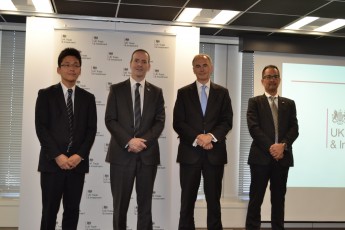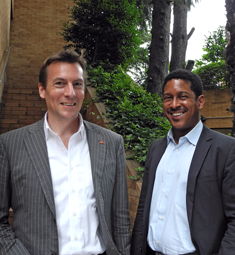Sony helps Winchester firm market device to end line call errors
When Frank Lampard let fly from 18 meters, smashing the ball onto the underside of the crossbar and over the white line in the knockout stages of the 2010 FIFA World Cup, everyone could see he had scored a spectacular equaliser.
Everyone except the Uruguayan referee, that is.
England went on to lose the match against Germany in Bloemfontein, South Africa, and were condemned for once again raising the hopes of their long-suffering fans, only to blow it at the moment of truth.
England lost 4–1 but, had Lampard’s 39th-minute effort been correctly judged to be over the goal line, the score would have been pegged at 2–2. And England might—at last—have got one over their old foe.
The only English winner from that match was Hawk-Eye Innovations Ltd. The Winchester-based firm has developed a complex computer-based system designed to visually track the trajectory of a ball and help a referee determine whether a goal has been scored.
Although the concept behind the technology is straightforward, making it work has proved tricky.
Based on the principles of triangulation, Hawk-Eye’s technology uses images shot from different angles and timing data provided by an array of high-speed video cameras located in different positions within the stadium.
In each frame sent from every camera, the system is able to identify the group of pixels that corresponds to the image of the ball. It then calculates for each frame the three-dimensional position of the ball by comparing its location on at least two of the cameras simultaneously.
A series of frames builds up a record of the path along which the ball has travelled. It also “predicts” the trajectory of the ball and where it will interact with any of the features already programmed into the database—such as the goal.
The system generates a graphic image of the ball’s path and the playing area, meaning that information can be provided to the referee, television viewers or the coaching staff almost immediately.
Impressed by the invention, Sony Corporation paid an undisclosed sum for the firm in March 2011 and is further developing the system.
“Sony has contributed in many ways to improving the Hawk-Eye technology”, Koichi Yamanaka, deputy general manager of Sony’s Sports and Stadium Business Development Office, told BCCJ ACUMEN. “That support makes our operations and global marketing much easier.
“Sony believes that sport is key entertainment content, and the Hawk-Eye data calibration technology will bring interesting synergies with Sony’s legacy video technology—such as cameras—from the perspective of providing content”, Yamanaka said.
The system already has a solid track record, having been used by the UK’s Channel 4 as far back as May 2001 to follow the ball in a cricket test match between England and Pakistan.
By 2008, the International Cricket Council had introduced a referral system whereby Hawk-Eye could be used by a third umpire to adjudicate in a leg before wicket decision.
The same device was tested in 2005 by the International Tennis Federation in New York, and since has been deployed at The Wimbledon Championships, the Queen’s Club Championships and the Australian Open.
After the debacle in South Africa, FIFA President Sepp Blatter was finally convinced that technology needed to be introduced to stop errors blighting football. The decision was made to have a system in place by the next football World Cup (2014), to be held in Brazil.
A friendly international match between England and Belgium made use of the Hawk-Eye system in June this year, while an alternative product, GoalRef, is also undergoing testing.
As part of the introductory process for the new technology, Hawk-Eye was used at the 10-day Club World Cup in Japan, which started on 6 December. The tournament brought together the champions from each of the continental federations.
And, with supreme irony, the European federation was represented by the winners of last season’s UEFA Champions League—Chelsea.
One of the players who was set to come to Japan was none other than Frank Lampard.





